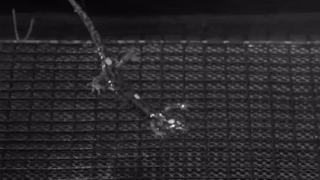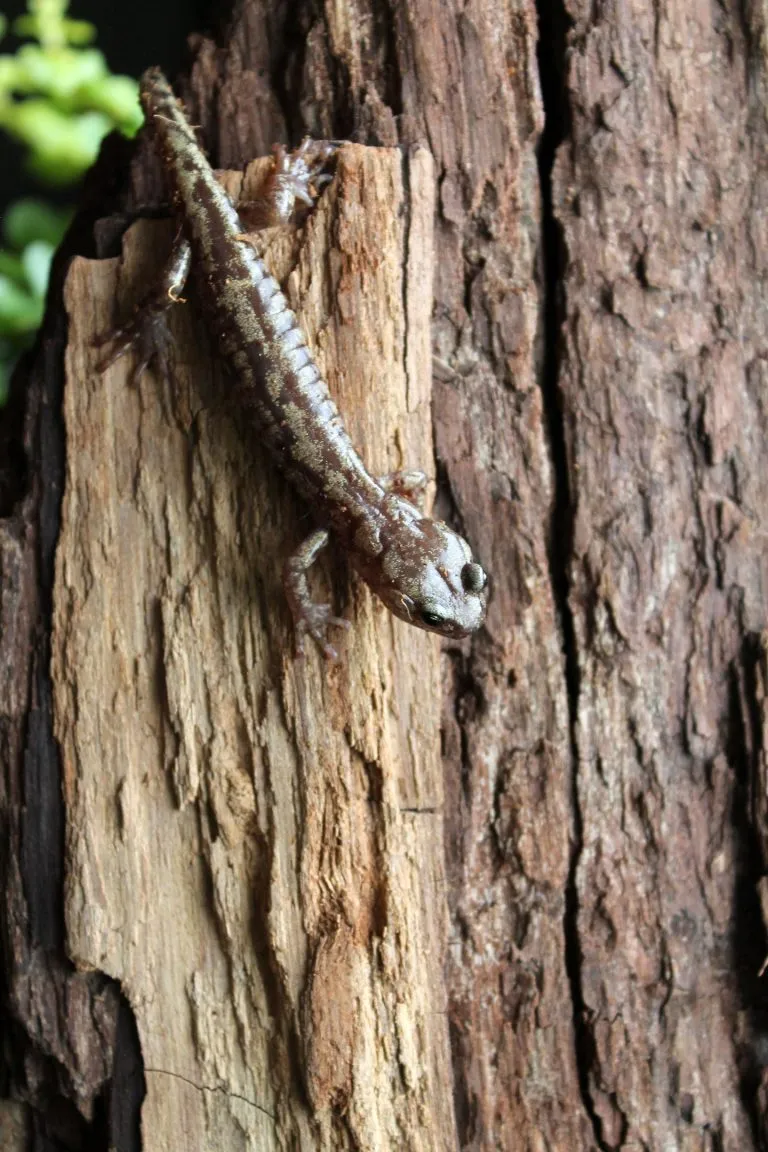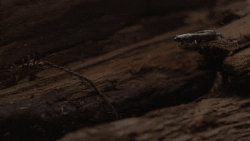The salamander has lived in the crown of the world's tallest tree, the California coast Sequoia, and has evolved a dangerous behavior that is well adapted to falling from a height: it can "parachute", glide and maneuver in mid air It is well known that flying mice, as well as many kinds of gliding frogs, geckos, ants and other insects, use similar "aerial acrobatics" when jumping from a tree to a tree or falling, so as to stay in the tree and avoid falling to the ground. Similarly, the researchers believe that the salamander's "skydiving" skill is a way to guide it back to the tree it fell or jumped from, so as to better avoid land predators.

Doctoral students at the University of South Florida (USF) Christian brown, the lead author of a paper on these behaviors, said: "when they are 'skydiving', they have exquisite operational control. They can turn. If they are upside down, they can turn themselves over. They can maintain the posture of 'skydiving' and twitch their tails up and down for horizontal maneuver. This level of control is really impressive."
High speed video taken in a wind tunnel at the University of California, Berkeley, shows the air flexibility of so-called "wandering" salamanders, where salamanders are pushed from a habitat into an upward moving air column to simulate free fall.

Professor of comprehensive biology, University of California, Berkeley Robert Dudley, an animal flight expert, said: "when I first saw these videos, I was shocked that they (salamanders) were so smooth - there was no discontinuity or noise in their movement, they just 'surfed' completely in the air. For me, this means that this behavior is deeply rooted in their motor response, it (falling) It must occur at a reasonably high frequency in order to choose this behavior. And this is not just passive 'skydiving', they are not just downward 'skydiving'. They are obviously also doing lateral motion, which is what we call gliding. "
This behavior is even more surprising because these salamanders look no different from other salamanders that do not have air mobility, except for slightly larger foot pads. For example, they have no flaps, which will remind you of their "skydiving" ability.
"Stray salamanders have big feet, they have long legs, they have active tails. All these things are conducive to their aerial behavior. But people just assume that it's for climbing, because when we look at them, they use these characteristics to climb," Brown said. "So this is not really a dedicated aerodynamic control surface, but its function is both. It helps them climb, and it seems to help them parachute and glide."
The questions researchers hope to answer in future research include how salamanders manage to "parachute" and manipulate without obvious anatomical adaptation to gliding, and whether many other animals with similar air skills have never been noticed before.
"Salamanders are slow. You don't think they have a particularly fast response. This is life in the slow lane." "Flight control is a quick response to dynamic visual cues and can aim, orient and change your body position. So it's just a strange phenomenon. Anyway, this can happen often. How do we know?"
On May 23, 2022, researchers in contemporary biology 》A paper describing the behavior was published in the journal.
Life in the canopy
Using a wind tunnel, brown and Erik Sathe, a graduate student at the University of California, Berkeley, compared the gliding and skydiving behavior of A. vagrans - about 4 inches (10 cm) from the nose to the tip of the tail - with the ability of three other salamanders native to northern California. Each salamander has different degrees of arboreal - that is, the tendency to climb or live in trees. "Wandering" salamanders may spend their lives in a tree, moving up and down, but never touching the ground. They are the most skilled "skydivers". A related species, the so-called arboreal salamander, a. lugubris, lives on lower trees, such as oaks, and is almost as effective in skydiving and gliding.
Two of the least arboreal salamanders - Ensatina eschsholtzii, a salamander that lives in woodland, and a. flavipunctatus, a spotted black salamander that occasionally climbs trees - are basically ineffective swings for a few seconds in a wind tunnel. All four species are lung free salamanders, the largest family of salamanders, mainly distributed in the Western Hemisphere.
"The two least arboreal species are often tossed around. We call it ineffective, undulating motion because they don't slide, they don't move horizontally, they just hover a little in the wind tunnel and are scared," Brown said. "The two most arboreal species have never actually patted."
Brown met these salamanders while working with non-profit organizations and University conservation groups in Humboldt and delnott counties, California. These animals live in the canopy of redwood trees, mainly in ancient forests about 150 feet above the ground. Biologists use ropes and risers to regularly climb mahogany - the tallest of which is up to 380 feet - to catch and mark wandering salamanders. Over the past 20 years, as part of a project led by James Campbell spickler, researchers have found that most of the salamanders they marked can be found in the same tree year after year, albeit at different heights. They mainly live in fern mats growing in bushes, which are rotten plant material gathered at the joints of large branches. Brown said the marked "wandering" salamanders from the rosewood canopy were rarely found on the ground, and most of them were found dead.

Brown noticed that when they were picked up and marked, the salamanders quickly jumped out of his hands. Even a gentle tap on a branch or a passing shadow is enough to make them jump off the mahogany crown. Considering that they are above the forest floor, it is surprising that they jump into the thin air in no hurry.
"They jumped, and before they finished their toes off the ground, they had spread out their forelimbs and were ready to go," he said. "Therefore, jumping and 'skydiving' are very closely linked. They immediately assume this position."
Dudley, who has studied this behavior in other animals, invited brown to bring some salamanders into his wind tunnel to record their behavior. Using a high-speed camera of 400 frames per second, the researchers photographed the salamanders floating on the air column for a period of time, sometimes up to ten seconds.
They then analyzed the frames to determine the animal's posture in mid air and infer how they use their legs, bodies and tails to manipulate. They usually fall at a steep angle, only 5 degrees from the vertical, but depending on the distance between the branches in the Redwood crown, this is usually enough for them to reach the branch or trunk before landing. Skydiving reduced their free fall speed by about 10%.
Brown suspects that their aerial skills evolved in response to falling, but have become part of their behavioral repertoire, perhaps their default descent method. For example, he and University of Southern California Undergraduate Jessalyn aretz found that it was much more difficult for salamanders to walk down than on horizontal branches or trunks.
"This shows that when they are wandering, they are likely to walk on a flat surface, or they are walking upward." He said: "When they run out of habitat, as the upper canopy becomes drier and there is nothing else on it for them to use, they can fall directly back to those better habitats. Why walk back? You may be tired. You've used up all your energy, you're a 5g little salamander, and you've just climbed up the tallest tree on earth. You won't turn around and walk down - you'll take a gravity elevator. ”
Brown believes that A. vagrans is another typical representative of ancient forests. It is similar to spotted owl because it is mainly found on the crown of the tallest and oldest sequoia trees, although it is also found in Douglas fir and Sitka spruce.
"This salamander is a typical representative of a part of the Sequoia forest, which has almost completely lost the logging canopy world." "It doesn't exist in these newly growing forests created by logging companies. Maybe it helps not only to protect Sequoia, but also to restore Sequoia, so that we can really get the canopy ecosystem. Restoring Sequoia to the steps of ferns and salamanders in the canopy - this will be a new protection standard," he said
Meanwhile, Dudley says the inhabitants of this ancient forest have a lot to tell us about evolution and perhaps the origin of flight.
"It [gliding]," Dudley said It's a novelty, something unexpected in a group of animals that have been well studied in other aspects, but it shows the urgency that animals living in trees must evolve aerial ability, even if they don't have wings. Flight, in the sense of controlling air behavior, is very common. They are controlling their body posture, and they are moving laterally. This makes many things living in trees eventually evolve into flapping flight, which may be difficult to evolve, which is why it only appears three times on earth today. "